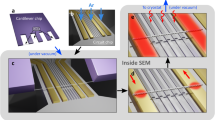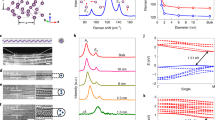Abstract
The connection of electrical leads to wire-like molecules is a logical step in the development of molecular electronics, but also allows studies of fundamental physics. For example, metallic carbon nanotubes1 are quantum wires that have been found to act as one-dimensional quantum dots2,3, Luttinger liquids4,5, proximity-induced superconductors6,7 and ballistic8 and diffusive9 one-dimensional metals. Here we report that electrically contacted single-walled carbon nanotubes can serve as powerful probes of Kondo physics, demonstrating the universality of the Kondo effect. Arising in the prototypical case from the interaction between a localized impurity magnetic moment and delocalized electrons in a metallic host, the Kondo effect has been used to explain10 enhanced low-temperature scattering from magnetic impurities in metals, and also occurs in transport through semiconductor quantum dots11,12,13,14,15,16,17,18. The far greater tunability of dots (in our case, nanotubes) compared with atomic impurities renders new classes of Kondo-like effects19,20 accessible. Our nanotube devices differ from previous systems in which Kondo effects have been observed, in that they are one-dimensional quantum dots with three-dimensional metal (gold) reservoirs. This allows us to observe Kondo resonances for very large electron numbers (N) in the dot, and approaching the unitary limit (where the transmission reaches its maximum possible value). Moreover, we detect a previously unobserved Kondo effect, occurring for even values of N in a magnetic field.
This is a preview of subscription content, access via your institution
Access options
Subscribe to this journal
Receive 51 print issues and online access
$199.00 per year
only $3.90 per issue
Buy this article
- Purchase on Springer Link
- Instant access to full article PDF
Prices may be subject to local taxes which are calculated during checkout




Similar content being viewed by others
References
Dekker, C. Carbon nanotubes as molecular quantum wires. Phys. Today 52, 22–28 (1999).
Tans, S. et al. Individual single-walled carbon nanotubes as quantum wires. Nature 386, 474–477 ( 1997).
Bockrath, M. et al. Single-electron transport in ropes of carbon nanotubes. Science 275, 1922–1925 ( 1997).
Bockrath, M. et al. Luttinger-liquid behaviour in carbon nanotubes. Nature 397, 598–601 ( 1999).
Yao, Z., Postma, H. W. C., Balents, L. & Dekker, C. Carbon nanotube intramolecular junctions. Nature 402 , 273–276 (1999).
Kasumov, A. Y. et al. Supercurrents through single-walled carbon nanotubes. Science 284, 1508–1511 ( 1999).
Morpurgo, A. F., Kong, J., Marcus, C. & Dai, H. Gate-controlled superconducting proximity effect in carbon nanotubes. Science 286, 263–265 (1999).
Frank, S., Poncharal, S. P., Wang, Z. L. & de Heer, W. A. Carbon nanotube quantum resistors. Science 280, 1744–1746 (1998).
Bachtold, A. et al. Aharonov–Bohm oscillations in carbon nanotubes. Nature 397, 673–675 ( 1999).
Hewson, A. C. The Kondo Problem to Heavy Fermions (Cambridge Univ. Press, Cambridge, 1993).
Glazman, L. I. & Raikh, M. E. Resonant Kondo transparency of a barrier with quasilocal impurity states. JETP Lett. 47, 452–455 ( 1988).
Ng, T. K. & Lee, P. A. On-site Coulomb repulsion and resonant tunneling. Phys. Rev. Lett. 61, 1768– 1771 (1988).
Meir, Y., Wingreen, N. S. & Lee, P. A. Low-temperature transport through a quantum dot: the Anderson model out of equilibrium. Phys. Rev. Lett. 70, 2601–2604 (1993).
Goldhaber-Gordon, D. et al. Kondo effect in a single-electron transistor. Nature 391, 156–159 ( 1998).
Goldhaber-Gordon, D. et al. From the Kondo regime to the mixed-valence regime in a single-electron transistor. Phys. Rev. Lett. 81, 5225– 5228 (1998).
Cronenwett, S. M., Oosterkamp, T. H. & Kouwenhoven, L. P. A tuneable Kondo effect in quantum dots. Science 281, 540–544 ( 1998).
Schmid, J., Weis, J., Eberl, K. & v. Klirtzing, K. A quantum dot in the limit of strong coupling to reservoirs. Physica B 256–258, 182–185 ( 1998).
Simmel, F., Blick, R. H., Kotthaus, J. P., Wegscheider, W. & Bichler, M. Anomalous Kondo effect in a quantum dot at nonzero bias. Phys. Rev. Lett. 83, 804–807 (1999).
Sasaki, S. et al. A novel Kondo effect in an integer-spin quantum dot. Nature 405, 764–767 ( 2000).
Pustilnik, M., Avishai, Y. & Kikoin, K. Quantum dots with even number of electrons: Kondo effect in a finite magnetic field. Phys. Rev. Lett. 84, 1756–1759 (2000).
Nygård, J., Cobden, D. H., Bockrath, M., McEuen, P. L. & Lindelof, P. E. Electrical transport measurements on single-walled carbon nanotubes. Appl. Phys. A 69 , 297–304 (1999).
Soh, H. T. et al. Integrated nanotube circuits: Controlled growth and ohmic contacting of single-walled carbon nanotubes. Appl. Phys. Lett. 75, 627–629 ( 1999).
Glazman, L. I. Single electron tunneling. J. Low Temp. Phys. 118, 247–269 (2000).
Tans, S., Devoret, M. H., Groeneveld, R. J. A. & Dekker, C. Electron–electron correlations in carbon nanotubes. Nature 394, 761–764 ( 1998).
Cobden, D. H., Bockrath, M., McEuen, P. L., Rinzler, A. G. & Smalley, R. E. Spin splitting and even-odd effects in carbon nanotubes. Phys. Rev. Lett. 81, 681–684 (1998).
Thess, A. et al. Crystalline ropes of metallic carbon nanotubes. Science 273, 483–487 ( 1996).
Acknowledgements
We thank A. Rinzler and R. Smalley for supplying the nanotubes, K. G. Rasmussen, M. M. Andreasen, A. E. Hansen and A. Kristensen for experimental assistance, and M. Pustilnik, N. Wingreen, L. P. Kouwenhoven, N. d'Ambrumenil, P. R. Poulsen and P. L. McEuen for helpful discussions.
Author information
Authors and Affiliations
Corresponding author
Rights and permissions
About this article
Cite this article
Nygård, J., Cobden, D. & Lindelof, P. Kondo physics in carbon nanotubes. Nature 408, 342–346 (2000). https://doi.org/10.1038/35042545
Received:
Accepted:
Issue Date:
DOI: https://doi.org/10.1038/35042545
This article is cited by
-
Nano-assembled open quantum dot nanotube devices
Communications Materials (2024)
-
Two-impurity Kondo effect in potassium-doped single-layer p-sexiphenyl films
Science China Physics, Mechanics & Astronomy (2022)
-
Kondo effect and spin–orbit coupling in graphene quantum dots
Nature Communications (2021)
-
Temperature induced shifts of Yu–Shiba–Rusinov resonances in nanowire-based hybrid quantum dots
Communications Physics (2020)
-
Theoretical calculation of simple and doped CNTs with the potential adsorption of various ions for water desalination technologies
Structural Chemistry (2020)
Comments
By submitting a comment you agree to abide by our Terms and Community Guidelines. If you find something abusive or that does not comply with our terms or guidelines please flag it as inappropriate.



